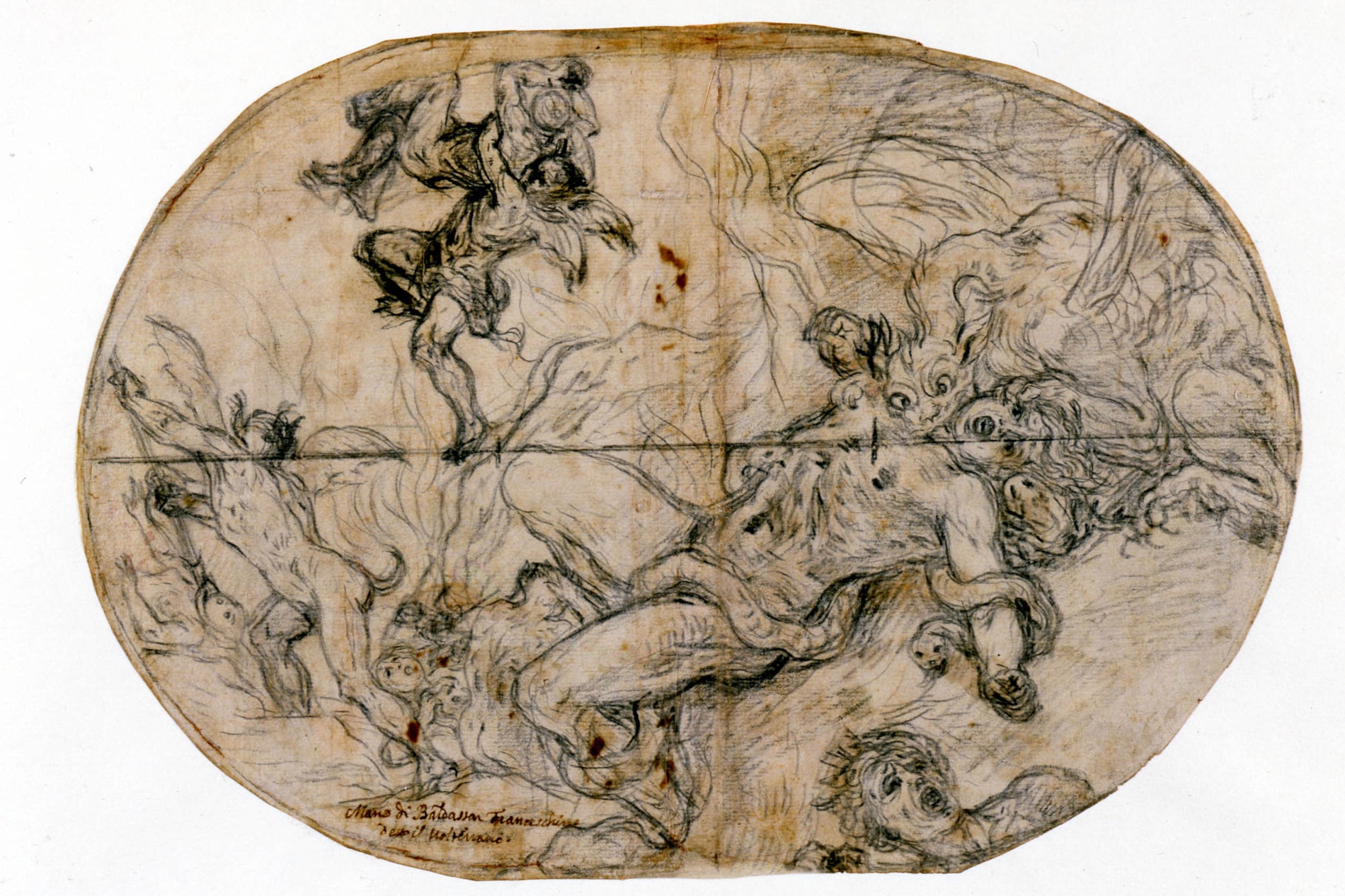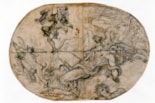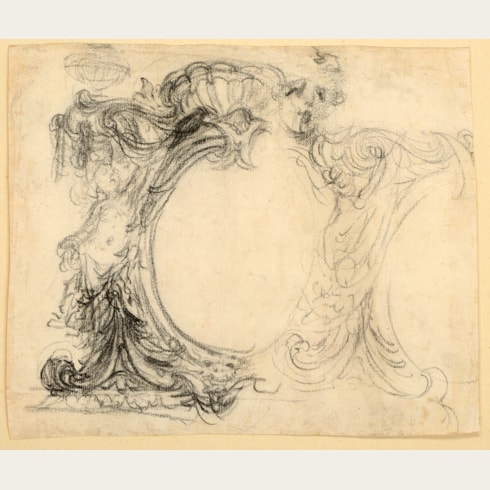Baldassare Franceschini VOLTERRANO
(Volterra 1611 - Florence 1690)
Devils Dragging Damned Souls into Hell
Sold
Black chalk, with touches of red chalk. A horizontal dividing line and oval framing lines drawn in black chalk, and the sheet trimmed to an oval.
The verso rubbed with red chalk.
Inscribed (by Giuseppe Santini) Mano di Baldassar Franceschini / detto il Volterrano at the lower left.
256 x 370 mm. (10 1/8 x 14 1/2 in.) at greatest dimensions.
The verso rubbed with red chalk.
Inscribed (by Giuseppe Santini) Mano di Baldassar Franceschini / detto il Volterrano at the lower left.
256 x 370 mm. (10 1/8 x 14 1/2 in.) at greatest dimensions.
This powerful sheet, which appears to be unrelated to any surviving painting or fresco by the artist, is a splendid example of Volterrano’s bold and vigorous draughtsmanship.
The inscription at the lower left of the sheet is in the hand of the collector recently identified as the 17th century military engineer and amateur landscape draughtsman Giuseppe Santini. A native of Pisa and a pupil of the sculptor Ferdinando Tacca, Santini was also a disciple of Stefano della Bella. As a draughtsman, he produced a number of landscape and genre drawings in pen in the manner of Ercole Bazzicaluva and Giulio Parigi. Santini also seems to have been an avid collector of the drawings of his Florentine contemporaries, and in particular those of Volterrano, each of which he inscribed with his distinctive handwriting before pasting them into an album. One such album, containing around thirty red chalk drawings by Volterrano and bearing similar inscriptions, is in the Fondazione Roberto Longhi in Florence, while other individual Volterrano drawings from Santini’s collection are in museum collections or have occasionally appeared on the art market.
The inscription at the lower left of the sheet is in the hand of the collector recently identified as the 17th century military engineer and amateur landscape draughtsman Giuseppe Santini. A native of Pisa and a pupil of the sculptor Ferdinando Tacca, Santini was also a disciple of Stefano della Bella. As a draughtsman, he produced a number of landscape and genre drawings in pen in the manner of Ercole Bazzicaluva and Giulio Parigi. Santini also seems to have been an avid collector of the drawings of his Florentine contemporaries, and in particular those of Volterrano, each of which he inscribed with his distinctive handwriting before pasting them into an album. One such album, containing around thirty red chalk drawings by Volterrano and bearing similar inscriptions, is in the Fondazione Roberto Longhi in Florence, while other individual Volterrano drawings from Santini’s collection are in museum collections or have occasionally appeared on the art market.
The preeminent fresco painter in Florence in the latter half of the 17th century, Baldassare Franceschini, known as Il Volterrano after his birthplace, studied with Matteo Rosselli and Giovanni da San Giovanni. His first significant independent commission came in 1636, when he was entrusted by Prince Don Lorenzo de’ Medici with the fresco decoration of the courtyard of the Medici villa of La Petraia, near Florence. This cycle of scenes from Medici history was not completed for another twelve years, however, as other commissions interrupted the project.
Volterrano painted frescoes, altarpieces and easel pictures for numerous churches and palaces in Florence, Volterra and Rome. His large-scale, crowded fresco compositions reflect an adaptation into a Florentine idiom of the Roman Baroque manner, derived from Pietro da Cortona’s frescoes in the Palazzo Pitti, where Volterrano himself also worked, decorating the ceiling of the Sala di Vittoria della Rovere. His painting style also shows the influence of Correggio, whose work in Parma he studied extensively; indeed one of Volterrano’s biographers, Niccolò Gabburri, describes the artist as ‘il secondo Correggio o pure il Coreggio dei Fiorentini.’
In 1650 Volterrano painted a large fresco of The Angels Ministering to Christ in the Wilderness for the refectory of the Florentine convent of Santa Teresa, a work he considered to be one of his finest achievements. Some of the artist’s most significant commissions were for Santissima Annunziata in Florence, where his fresco decoration of the chapel of Sant’Ansano in 1643 began an association with the church that was to last almost to the end of his career. Between 1664 and 1683, Volterrano executed paintings for the ceiling of the nave of the church and an altarpiece of San Filippo Benizzi in Glory, and his work at Santissima Annunziata culminated in the cupola fresco of The Coronation of the Virgin. Commissioned by the Grand Duke Cosimo III, the fresco was the artist’s last major project, as he suffered a stroke shortly after its completion.
Undoubtedly one of the finest draughtsmen of the Florentine Seicento, Volterrano, as one modern scholar has noted, ‘can take his place alongside the other major draughtsmen of the Baroque era; there is nothing provincial about any aspect of his drawing.’ Both of the artist’s biographers, Filippo Baldinucci and Francesco Maria Niccolò Gabburri, owned several of his drawings, and they were also popular with collectors. The largest extant groups of drawings by Volterrano are today in the collections of the Uffizi and the Albertina, while a number of designs for architecture, decorative motifs and metalwork are in the Kunstbibliothek in Berlin.
Provenance
Giuseppe Santini, Florence, with his inscription at the lower left of the sheet
Anonymous sale, London, Christie’s, 9 April 1990, lot 29.
Literature
Marta Privitera, ‘Disegno del Volterrano per i dipinti di Ferdinando Ridolfi’, Paragone, September-November 2000, p.85, note 65, pl.78; London and New York, Jean-Luc Baroni Ltd., Master Drawings and Oil Sketches, 2005, under no.17.





